Practice Free MS-102 Exam Online Questions
Topic 4, Fabrikam
Overview
Fabrikam, Inc. is an electronics company that produces consumer products. Fabrikam has 10,000 employees worldwide.
Fabrikam has a main office in London and branch offices in major cities in Europe, Asia, and the United States.
Existing Environment
Active Directory Environment
The network contains an Active Directory forest named fabrikam.com. The forest contains all the identities used for user and computer authentication. Each department is represented by a top-level organizational unit (OU) that contains several child OUs for user accounts and computer accounts.
All users authenticate to on-premises applications by signing in to their device by using a UPN format of [email protected].
Fabrikam does NOT plan to implement identity federation.
Network Infrastructure
Each office has a high-speed connection to the Internet.
Each office contains two domain controllers. All domain controllers are configured as DNS servers.
The public zone for fabrikam.com is managed by an external DNS server.
All users connect to an on-premises Microsoft Exchange Server 2016 organization. The users access their email by using Outlook Anywhere, Outlook on the web, or the Microsoft Outlook app for iOS. All the Exchange servers have the latest cumulative updates installed.
All shared company documents are stored on a Microsoft SharePoint Server farm.
Requirements
Planned Changes
Fabrikam plans to implement a Microsoft 365 Enterprise subscription and move all email and shared documents to the subscription.
Fabrikam plans to implement two pilot projects:
Project1: During Project1, the mailboxes of 100 users in the sales department will be moved to Microsoft 365.
Project2: After the successful completion of Project1, Microsoft Teams will be enabled in Microsoft 365 for the sales department users.
Fabrikam plans to create a group named UserLicenses that will manage the allocation of all Microsoft 365 bulk licenses.
Technical Requirements
Fabrikam identifies the following technical requirements:
All users must be able to exchange email messages successfully during Project1 by using their current email address.
Users must be able to authenticate to cloud services if Active Directory becomes unavailable.
A user named User1 must be able to view all DLP reports from the Microsoft Purview compliance portal.
Microsoft 365 Apps for enterprise applications must be installed from a network share only.
Disruptions to email access must be minimized.
Application Requirements
Fabrikam identifies the following application requirements:
An on-premises web application named App1 must allow users to complete their expense reports online. App1 must be available to users from the My Apps portal.
The installation of feature updates for Microsoft 365 Apps for enterprise must be minimized.
Security Requirements
Fabrikam identifies the following security requirements:
After the planned migration to Microsoft 365, all users must continue to authenticate to their mailbox and to SharePoint sites by using their UPN.
The membership of the UserLicenses group must be validated monthly. Unused user accounts must be removed from the group automatically.
After the planned migration to Microsoft 365, all users must be signed in to on-premises and cloud-based applications automatically.
The principle of least privilege must be used.
You are evaluating the required processes for Project1.
You need to recommend which DNS record must be created while adding a domain name for the project.
Which DNS record should you recommend?
- A . host (A)
- B . host information
- C . text (TXT)
- D . alias (CNAME)
B
Explanation:
When you add a custom domain to Office 365, you need to verify that you own the domain. You can do this by adding either an MX record or a TXT record to the DNS for that domain.
Note:
There are several versions of this question in the exam. The question has two possible correct answers:
Text (TXT)
Mail exchanger (MX)
incorrect answer options you may see on the exam include the following:
alias (CNAME)
Host (A)
host (AAA)
Pointer (PTR)
Name Server (NS)
host information (HINFO)
pointer (PTR)
Reference: https://docs.microsoft.com/en-us/office365/admin/get-help-with-domains/create-dns-records-at-any-dns-hosting-provider
HOTSPOT
Your company uses a legacy on-premises LDAP directory that contains 100 users.
The company purchases a Microsoft 365 subscription.
You need to import the 100 users into Microsoft 365 by using the Microsoft 365 admin center.
Which type of file should you use and which properties are required? To answer, select the appropriate options in the answer area. NOTE: Each correct selection is worth one point.
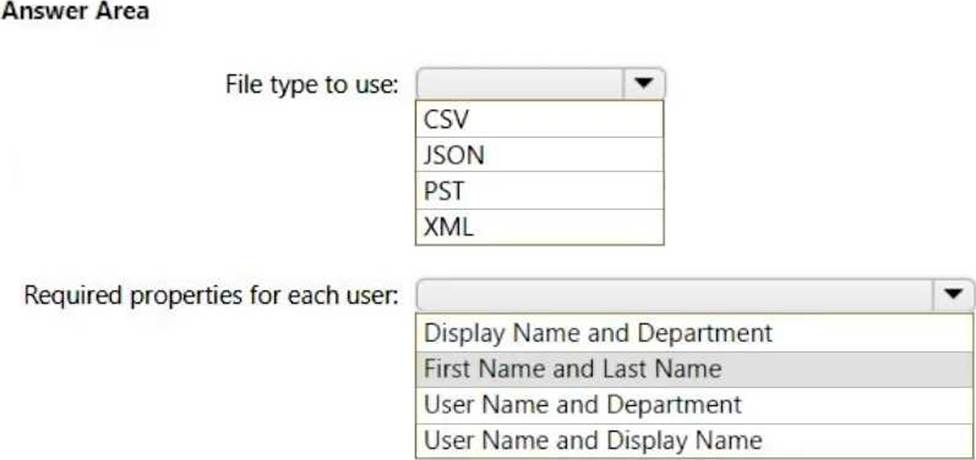
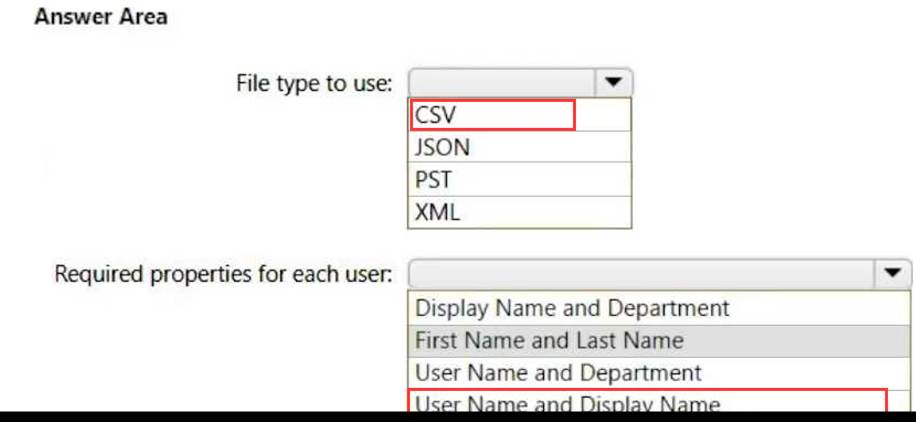
Explanation:
Box 1: CSV
Add multiple users in the Microsoft 365 admin center
Sign in to Microsoft 365 with your work or school account.
In the admin center, choose Users > Active users.
Select Add multiple users.
On the Import multiple users panel, you can optionally download a sample CSV file with or without sample data filled in.
Etc.
Note: More information about how to add users to Microsoft 365 Not sure what CSV format is?
A CSV file is a file with comma separated values. You can create or edit a file like this with any text editor or spreadsheet program, such as Excel.
Box 2: User Name and Display Name
What if I don’t have all the information required for each user? The user name and display name are required, and you cannot add a new user without this information. If you don’t have some of the other information, such as the fax, you can use a space plus a comma to indicate that the field should remain blank.
Reference: https://learn.microsoft.com/en-us/microsoft-365/enterprise/add-several-users-at-the-same-time
HOTSPOT
You have a Microsoft 365 subscription that contains the users shown in the following table.

You need to configure a dynamic user group that will include the guest users in any department that contains the word Support.
How should you complete the membership rule? To answer, select the appropriate options in the answer area. NOTE: Each correct selection is worth one point.


Explanation:
Box 1: -eq "Guest"
Dynamic membership rules for groups in Azure Active Directory
Supported expression operators
The following table lists all the supported operators and their syntax for a single expression. Operators can be used with or without the hyphen (-) prefix. The Contains operator does partial string matches but not item in a collection matches.
* Equals -eq
* Contains -contains
* Etc.
Box 2: -contains "Support"
Incorrect:
* -in
If you want to compare the value of a user attribute against multiple values, you can use the -in or – notIn operators.
Reference: https://learn.microsoft.com/en-us/azure/active-directory/enterprise-users/groups-dynamic-membership
You have a Microsoft 365 E5 subscription that uses Microsoft Defender for Office 365 and contains a user named User1.
User1 emails a product catalog in the PDF format to 300 vendors. Only 200 vendors receive the email message, and User1 is blocked from sending email until the next day.
You need to prevent this issue from reoccurring.
What should you configure?
- A . anti-spam policies
- B . Safe Attachments policies
- C . anti-phishing policies
- D . anti-malware policies
Your company has a Microsoft 365 subscription.
You need to identify all the users in the subscription who are licensed for Office 365 through a group membership. The solution must include the name of the group used to assign the license.
What should you use?
- A . Active users in the Microsoft 365 admin center
- B . Reports in Microsoft Purview compliance portal
- C . the Licenses blade in the Microsoft Entra admin center
- D . Reports in the Microsoft 365 admin center
You have a Microsoft 365 tenant that contains a Windows 10 device named Device1 and the Microsoft Endpoint Manager policies shown in the following table.
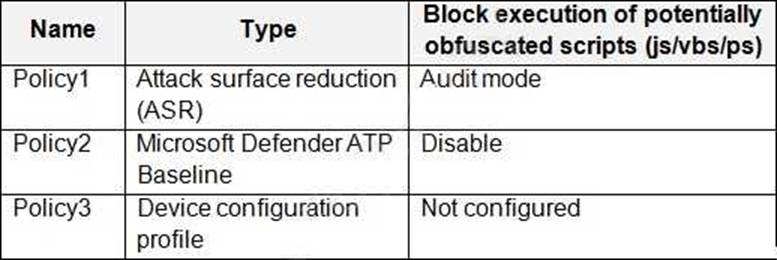
The policies are assigned to Device1.
Which policy settings will be applied to Device1?
- A . only the settings of Policy1
- B . only the settings of Policy2
- C . only the settings of Policy3
- D . no settings
HOTSPOT
You have a Microsoft 365 E5 subscription that contains the users shown in the following table.
Each user has an Android device with the Microsoft Authenticator app installed and has set up phone sign-in.
The subscription has the following Conditional Access policy:
• Name: Policy1
• Assignments
o Users and groups: Group1, Group2
o Cloud apps or actions: All cloud apps
• Access controls
o Grant Require multi-factor authentication
• Enable policy: On
From Microsoft Authenticator settings for the subscription, the Enable and Target settings are configured as shown in the exhibit. (Click the Exhibit tab.)
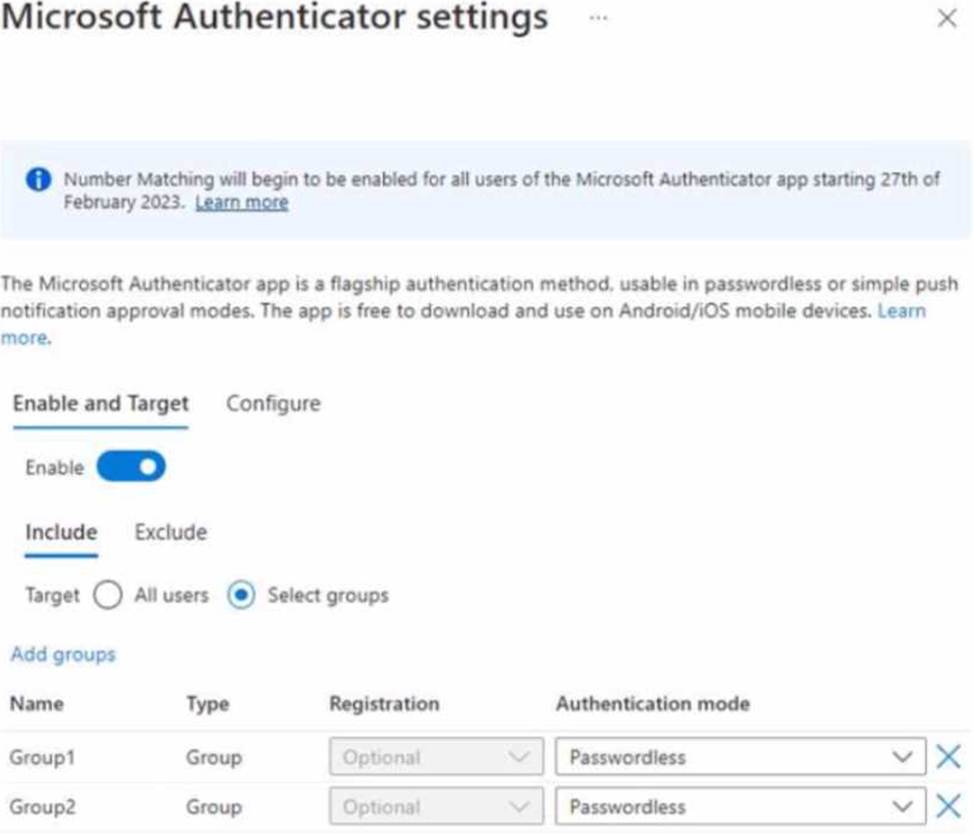
For each of the following statements, select Yes if the statement is true. Otherwise, select No. NOTE: Each correct selection is worth one point.


You have a Microsoft 365 E5 tenant that has sensitivity label support enabled for Microsoft and SharePoint Online.
You need to enable unified labeling for Microsoft 365 groups.
Which cmdlet should you run?
- A . set-unifiedGroup
- B . Set-Labelpolicy
- C . Execute-AzureAdLebelSync
- D . Add-UnifiedGroupLinks
HOTSPOT
You have a Microsoft 365 E5 subscription.
You need to create a Conditional Access policy that will require the use of FID02 security keys only when users join their Windows devices to Microsoft Entra ID.
How should you configure the policy? To answer, select the appropriate options in the answer area. NOTE Each correct selection is worth one point.
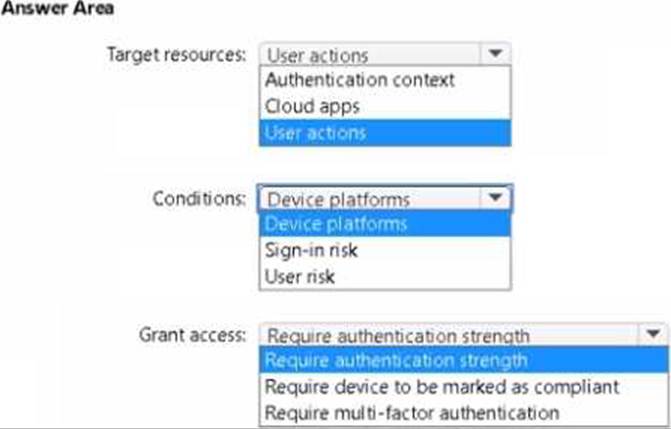
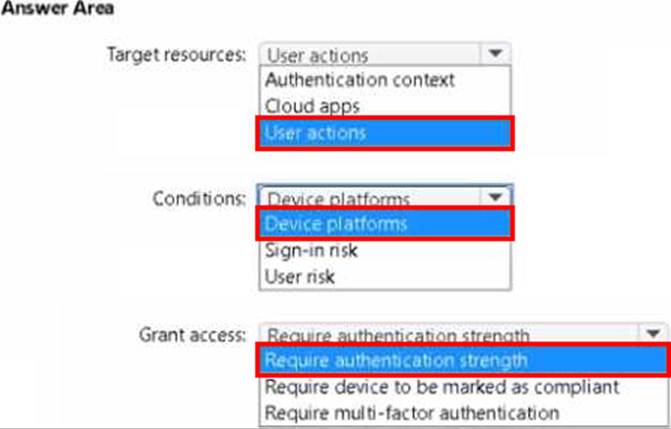
HOTSPOT
You have a Microsoft 365 subscription that contains the users shown in the following table.
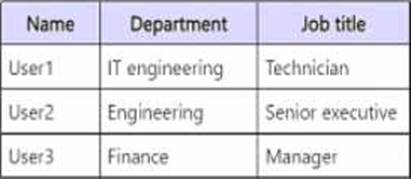
You create a new administrative unit named AU1 and configure the following AU1 dynamic membership rule.
The subscription contains the role assignments shown in the following table.
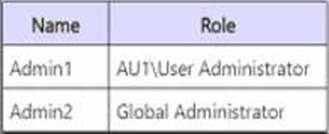
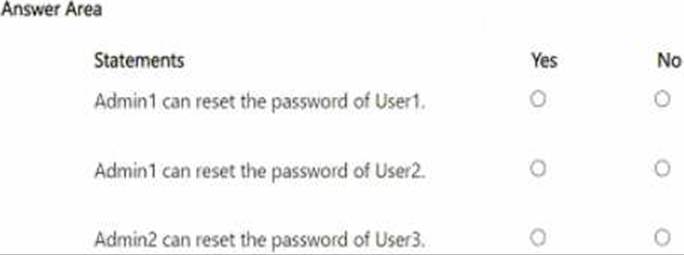
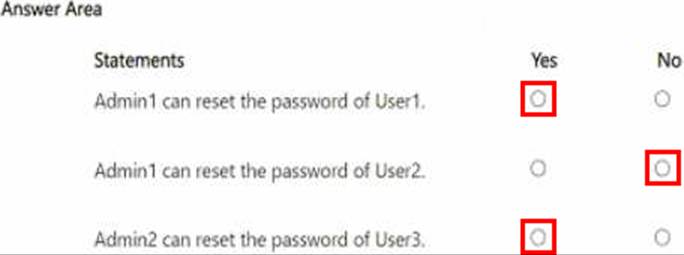
Explanation:
Admin1 can reset the password of User1: Yes
Admin1 has the User Administrator role within AU1. User1 is a member of Group1, which is included in AU1’s dynamic membership rule.
Admin1 can reset the password of User2: No
User2 is a member of both Group1 and Group2. However, User2’s job title contains "Executive," which excludes them from AU1’s dynamic membership rule. Therefore, Admin1 cannot reset User2’s password.
Admin2 can reset the password of User3: Yes
Admin2 has the Global Administrator role, which grants the ability to reset passwords for any user within the organization, including User3.
